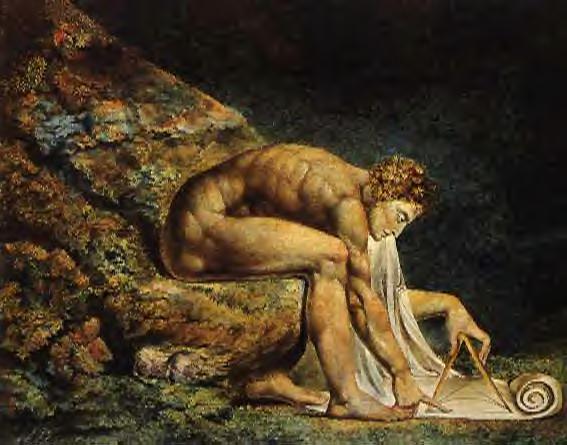Serendip is an independent site partnering with faculty at multiple colleges and universities around the world. Happy exploring!
Week One (Wed, 1/19): Defining Our Terms/Beginning Our Dialogue
I. To open: Paul Simon, “The Boy in the Bubble”:
"These are the days of miracle and wonder
This is the long distance call….”

William Blake's depiction of "Newton" (1795)--
what do you see??
II. Anne: Defining our own terms
Find someone you haven't talked w/ before:
say who you are, and tell them a story about
your first/most profound experience of doing science
Second go ‘round, same partner: tell them a story of when
you were first/most clearly aware that you were gendered
Write for a few moments, metaphorizing:
What metaphor for gender evokes both your
experience and that of your neighbor?
What metaphor for science might do the same?
What metaphor might describe the interaction of gender and science?
Call 'em out/write 'em up.
We "want to go back to that lost forest where metaphors mix, rub shoulders with each other and everything turns into everything else." (Suniti Namjoshi, epigraph to Banu Subramaniam's "Moored Metamorphoses," Signs 2009)
How might we summarize the similarities and differences among us?
Can we say anything collective about our experiences?
How might we generalize from our reactions/particularities:
What is gender? What is science?
What is the relation between them? (and/or?)
HERE ARE OUR METAPHORS FOR THE
INTERSECTION OF GENDER AND SCIENCE:
boat
cyborg
ocean
contradictory
closing your eyes before firing a gun
something in a covered box
looking for the answer before the question
uncertain
childhood
development
not consistent
warping
a bar fight
car chase
container
changing
search engine
glacier
oil and water
dicotomy
space
Bryn Mawr
teacher
prescriptive
wall or boundary
continuous debate
conflicting freedom
stream
struggle
ice cream in the summertime
volcano
evolution
game of Jenga
interdependent
Cf. w/ definitions from the Oxford English Dictionary
Gender: (from L. genus, race)
general or common -->
genus (as opposed to species) -->
kin, kind, sort, class (cf. "genre")
–in mod. (esp. feminist) use, a euphemism for the sex of a human being, to emphasize the social and cultural, as opposed to the biological, distinctions between the sexes
--in this class, more abstractly, theoretically: gender
refers to acts of "sorting," "generalizing," "classifying"
Science: (from L. scientia, knowledge)
the state or fact of knowing; acquired by study, a trained skill;
"observed facts brought under general law";
cf'ed to art and/or conscience, "emphasizing the distinction
between theoretical truth and moral conviction"
(con- together + scīre to know: "to know along with another")
How are these dictionary definitions like/different from/expanding on/focusing in on the ones we've just generated for ourselves?
WHAT METAPHOR MIGHT THE O.E.D. OFFER, FOR THE
INTERSECTION OF ITS DEFINITIONS OF GENDER AND SCIENCE??
This is (in part! it has many parts!) a course about
the “sorting”/”generalizing” that is gender,
intra-acting w/ the “knowing" that is science
(in a few days, we'll add "information" and "technology" to our vocabulary)
a very important part of this project is its social nature:
on our learning together/assisting w/ one another's learning
![]()
The "monster" that was the "man-mid-wife"
III. Liz on how we hope to have this conversation:
co-constructive dialogue/ principles/ philosophy of the course
- mental models
- suspended choices
- collective solutions
Edgar Schein, Dialogue, Culture and Organizational Learning
(Organizational Dynamics, Winter 1993, 40-51)
IV. Anne (while you sign in/up!): our four-part plan
Weeks 1-4: THE SCIENCE AND TECHNOLOGY OF GENDER:
MAKING AND RE-MAKING OURSELVES
Weeks 5-7: THE SCIENCE AND TECHNOLOGY
OF INFORMATION: REPRESENTING THE WORLD
Weeks 8-10: "MOORED METAMORPHOSES": THE INTRA-
ACTION OF GENDER, INFORMATION, SCIENCE AND TECHNOLOGY
Weeks 11-14: CREATIVE COLLABORATIONS IN
GENDER, INFORMATION, SCIENCE AND TECHNOLOGY
Buy two books, by Joan Roughgarden and Mary Shelley
(contemporary ecology; 19th c. sci fi;
we'll select a third one together);
remainder of readings available on-line
Your task (should you choose to accept it)
is to do the reading and come prepared
to contribute to the conversation,
in person and in weekly on-line postings:
contributing to others' education as well as your own
you will create 3 4-pp. on-line projects/"events,"
be divided into two (randomized) writing groups
(and switch advisors mid-way); meet @ least once w/ each of us;
give a final performance w/ other students,
and create a final 12-pp. project
Grading (nope!)--but final portfolio and self-evaluation
Here's your (more immediate) homework:
for Monday's class, download/read/reflect
on two essays in our course repository:
Donna Haraway's classic 1991 essay, "A Cyborg Manifesto: Science, Technology, and Socialist-Feminism in the late Twentieth Century"
A 2008 interview w/ Donna Haraway, "There are
Always More Things Going On than You Thought!"
(HERE'S YOUR SECRET CODE to the password-protected file @ /~adalke/gender
where you'll find most of our course readings)
Also! by midnight on Fri: register for a Serendip account
(USING YOUR SECRET REGISTRATION CODE)
Then: introduce yourself in our on-line conversation by describing your relationship to a particular technology that has been important to your development (the clock, the bicycle, the piano, the personal computer, the cell phone...?). How have your interactions with this tool enabled you to do things you otherwise could not have done (possibly as easily, efficiently, or at all)? What are the limitations/constraints/drawbacks of this technology in your life? What new technologies have you not tried? Why not? Would you be interested in experimenting w/ them during this course?
To close, reprise: Paul Simon, “The Boy in the Bubble”:
These are the days of miracle and wonder
This is the long distance call….”



Comments
Post new comment